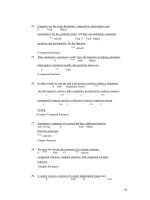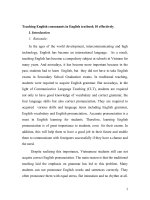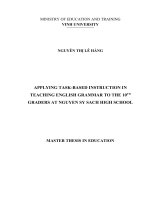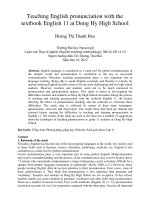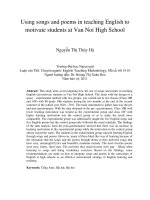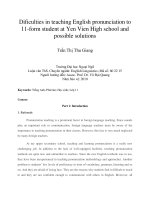SKKN: Teaching English consonants in English textbook 10 effectively.
Bạn đang xem bản rút gọn của tài liệu. Xem và tải ngay bản đầy đủ của tài liệu tại đây (174.78 KB, 22 trang )
Teaching English consonants in English textbook 10 effectively.
I. Introduction
1. Rationale:
In the ages of the world development, intercommunicating and high
technology, English has become an international language. As a result,
teaching English has become a compulsory subject at schools in Vietnam for
many years. And nowadays, it has become more important because in the
past, students had to learn English, but they did not have to take English
exams in Secondary School Graduation exams. In traditional teaching,
students were required to acquire English grammar. But nowadays, in the
light of Communicative Language Teaching (CLT), students are required
not only to have good knowledge of vocabulary and correct grammar, the
four language skills but also correct pronunciation. They are required to
acquired various skills and language items including English grammar,
English vocabulary and English pronunciation Accurate pronunciation is a
must in English learning for students. Therefore, learning English
pronunciation is of great importance to students, even for their exams. In
addition, this will help them to have a good job in their future and enable
them to communicate with foreigners successfully if they have a chance and
the need.
Despite realizing this importance, Vietnamese students still can not
acquire correct English pronunciation. The main reason is that the traditional
teaching laid the emphasis on grammar has led to this problem. Many
students can not pronounce English words and sentences correctly. They
often pronounce them with equal stress, flat intonation and no rhythm at all.
1
English pronunciation seems to have become the most serious problem that
students meet when they learn English. This is happening at almost upper
secondary schools in Vietnam except for foreign language specializing
schools.
Situated in the central part of the country, Ha Tinh is much poorer
than other provinces and have a lot of difficulties. Although Ha tinh is said
to be the place of study and gifts, it still has many weaknesses in terms of
teaching of learning because of some main reasons. Firstly, most of the
teachers are very young and lack of teaching experience. Furthermore, the
students here mostly come from poor families. They do not have good
conditions to study. Moreover, classes at Ha tinh upper secondary schools
are large, crowded and poorly equipped which make speaking lessons more
difficult. Therefore, learning condition in Ha Tinh is not really good except
for some schools in the city. As a certain, their learning English is really
bad. And if some students are said to be good at English, it means they are
good at English grammar. Most of them find it hard to express themselves
orally. If anyone can, he has problems in pronouncing English words and
sentences. In the English lessons, only teachers speak , and most of the time,
teachers have to speak Vietnamese because they are afraid that their students
do not understand what they are speaking. Although English has been
compulsory for many years, students in the province have not paid much
attention to it. If some students at Ha Tinh upper secondary schools invest
time to study the subject, it is just because of the exams they have to take.
Many students fail the national examination for the Secondary School
Diploma because they can not do English tests well. Due to this, students
here tend to concentrate on English subject more and more. However,
2
because of many factors, especially the objectives of the test, English
teaching and learning in this area focus much on grammar, not other skills.
Traditionally, teachers did not pay much attention to teaching pronunciation.
And the old English textbooks did not involve teaching pronunciation,
either. That is why pronunciation seems to be very difficult for most of the
students. Teachers here tend to ignore teaching pronunciation to the
students. When we teach our students with the new textbooks, most of them
are unwilling to have pronunciation lessons in Language Focus part, because
they find it hard to achieve as good and correct pronunciation as in the CD.
For the teachers and students at most of upper secondary schools in Ha
Tinh, pronunciation is a great problem. Most students complain about
difficulties they get in learning English speaking skill in general and in
pronunciation in particular with the new textbook. We ourselves realize that
our students really have bad pronunciation. As a result, students here have a
lot of problems when they do the tests on pronunciation as a part of the
graduate examinations. And they also get a lot of difficulties in speaking
English, even simple words or sentences. This is a serious problem not only
at Ha Tinh upper-secondary schools but also at many other mountainous and
remoted schools. So, investigating the problems and then find out some
suggestions to improve the situation are very helpful for teaching and
learning English at our school.
Because of these above reasons, I decided to do research on students’
difficulties in learning English pronunciation. But with the limitation of time
and space, I just focus on common English consonant problems and
techniques to improve the situation entitled: “An investigation into Ha Tinh
Upper Secondary students’difficulties in learning English consonants and
3
techniques to improve the situation”. The study was conducted to seek the
answers to the question of which English consonants students at upper
secondary schools often have difficulties with and what techniques should
be applied to help them overcome those difficulties.
2.The aims:
With the above rationale, my study was conducted with these
following main aims:
-To investigate the difficulties that Upper Secondary students meet
when they learn English consonants.
-To recommend some techniques for teachers and learners to
overcome these difficulties.
3. Scope of the study:
Because lack of research conditions and time, the study was only to
investigate the main English consonant problems.
The participants I chose for the research were only the students at my
schools. With classroom observation, I chose all the students in classes that I
attended to be the participants. With the experimental application, students
in two classes of grade 10
th
were chosen to do the designed exercises and
to test the results.
4. Research methodology:
The study employed different methods and instruments to get the data.
- With the first task, investigating the main consonant problems that students
often meet when they learn English, I mostly employed classroom
observation and note- taking as well as my own experience of teaching
English in Ha Tinh for many years.
4
- With the second task, checking whether the techniques I suggested are
effective or not, I did an experiment.
II. Literature review
1. Some main differences between the two language consonant
systems- A contrastive anlysis.
To find out the most common consonant problems that Vietnamese
high school students often meet, firstly, a comparison between the two
consonant systems should be made first because the consonant systems
between the two languages also differ greatly.
It is clear that there are a lot of differences in the comparison of
Vietnamese and English consonant systems. According to Roach, P. (1983),
English has twenty- four consonants. They are: p, b, m, f, v, t, d, k, g, θ, δ, s,
z, l, z, h, n, ŋ, r, j, w, t∫, dʒ, ∫. The classification of these consonants is based
on the manner of articulation and place of articulation. Vietnamese is different
from English. Vietnamese has 30 consonants. It has twenty-two initial
consonants pointed out by Doan Thien Thuat (initial consonants are ones
which stand at the beginning of a syllable) . They are : b, m, f, v, t, t, d, n, s,
z , l, ţ, ş, z, , c, …k, ŋ, x, γ, p, h. In addition to 22 initial consonants above,
Vietnamese has 8 final consonants including 6 consonants and 2 semi-
consonants or 2 semi- vowels.
Comparing the two consonant systems, we can see that, firstly, there
are some English consonants which do not exist in Vietnamese language such
as dʒ, θ, ð, j, w…That these symbols do not exist in Vietnamese is a great
difficulty for them to acquire. They are not familiar with these ones, so it is
5
very difficult for them to produce the correct sounds of these consonants.
Besides, learners have a confusion of similar sounds: /b/ and /p/, /dʒ/
and /ð, /θ/ and /th/…and have difficulty in pronouncing consonant clusters
such as /desks/, /fifθ/ in the words “desks” and “fifth” because consonant
clusters do not exist in Vietnamese.
Another difference that can cause pronunciation problems related to
grammar which do not occur in Vietnamese. That is ‘s-ending’ in plural
nouns, the third singular personal verbs (Simple Present tense) and “ed-
ending’ in regular past verbs and regular past participles. Vietnamese
learners often pronounce ‘s-ending’ as /s/ and ‘ed-ending’ as /ɪd/ but in fact
English is different and is not always pronounced like that. The main reason
for this is that in Vietnamese, there is no concept of the voiced consonants
and voiceless consonants. If teachers provide learners with some main
classifications of consonants including the state of the vocal cords (voiced
and voiceless), learners can avoid wrong pronunciation in this case. For
example, they can know when they pronounce ‘s-ending’ as /s/, /z/, /ɪz/ and
‘ed-ending’ as /ɪd/, /t/, /d/ for phonetic words ending in voiced, voiceless or
some specific sounds….
In addition, Vietnamese learners have a confusion of the form of the
indefinite article: ‘a/an’ and the way to pronounce definite article: ‘the’.
They know that ‘a’ stands before a consonant and ‘an’ before a vowel but
sometimes they can’t explain some problems such as a university, an M.P,
an hour…and they still make mistakes. Teachers need explain to them that
consonants and vowels here are phonetic words but not letters (ju:n
ɪ
vəsə
6
ti/, /mp
ɪ
/ and / a
ʊ
ə/ ) and the rule for a/an does not change. ‘The’ is
pronounced as /ðə/ when it stands before a consonant and as /ðɪ/ before a
vowel. Nevertheless, Vietnamese learners can not distinguish this without
realizing English phonetic symbols, specially consonants. Consequently,
teachers should pay attention to the missing knowledge of consonants of
learners in order to instruct them in time.
The above is a brief comparison between the two consonant systems
in which the main differences between Vietnamese consonant system and
the English one are pointed out so that we can analyze the main consonant
problems more easily.
2. Some common pronunciation problems.
Doff, A.(1988:113) pointed out that students in different countries
have different problems with English pronunciation. However, there are
some common pronunciation problems that learners often make when they
speak English. According to him, there are some main categories of common
problems that are likely to occur as followings:
- Difficulties in pronouncing sounds which do not exist in the
students’ own language. For example, the consonant /ð/ is of great hard for
Vietnamese students of English because this sound does not exist in
Vietnamese language.
- Confusion of similar sounds, e.g. /ð/ and /z/.
- Difficulty in pronouncing consonant clusters.
As I mentioned in the previous part, there are many consonants that
exist in English but do not exist in Vietnamese. So Vietnamese learners of
7
second English language often have many problems with the system of
English consonants. The problems that they have with English consonants
seem to be many more than the ones that they have with English vowels.
The followings are common mistakes that Vietnamese students often meet
when they speak English pointed out by Avery, P. and Ehrlich, S.(1992).
Problem 1: Word- final voiceless stop consonants :/p/, /t/, and /k/
In Vietnamese, the voiceless stop consonants /p/, /t/, and /k/ occur at
the end of a word, but these consonants are never released in final position
and is much shorter than their English equivalents. This means that even
when Vietnamese speakers pronounce these consonants in final position,
English speakers may have difficulty hearing them. Thus, a word such as
“beat” may sound like “ bee”.
Problem 2: Voiced and voiceless stops in word final position: /b/,
/d/, /g/, vs. /p/, /t/, /k/.
As Vietnamese has no voiced stops at the ends of words, Vietnamese
speakers need practise in distinguishing between voiced and voiceless stops
in this position. For example, words such as “cap” and “cab” may sound
identical, with a short unreleased /p/ at the end of both words.
Problem 3 : Word final fricative consonants : /f/, /v/, / θ/, /ð/,
/s/,/z/, /ʃ/ and /dʒ/.
In Vietnamese, fricatives /f/, /v/, / θ/, /ð/, /s/,/z/, /ʃ/ and /ʒ/ do not
occur at the final position of a word, but in English, they do. That is why
Vietnamese students often omit these fricatives at the ends of the sounds.
Problem 4 : / θ/ and /ð/ as in “thank” and “than”
8
In fact, these two consonants do not occur in Vietnamese. In stead,
there are two consonants in Vietnamese that make them difficult to
distinguish with these / θ/ and /ð/, they are “th” (sound like the aspirated
“t”) and “d”( sound like the consonant “z” in English. In fact, the manner of
producing these Vietnamese sounds are different from the two / θ/ and /ð/,
but their sounds seem a little the same. That is why Vietnamese students
often substitute a /d/ for /ð/ and a “t” for / θ/.
Problem 5 : Consonant clusters.
In Vietnamese, consonant clusters do not happen at the initial and
final position. When they speak English, they have to meet a lot of
consonant clusters that contain many consonants at the same time. This
causes a lot of difficulties for them because they are not familiar with this.
Often, Vietnamese students tend to omit one or two consonants in a
consonant cluster. For example, they may pronounce the word “ first”
into /fɜ:t/ or the word “looked” into /lʊk/ or /lʊt/.
Problem 6: “-ed” and “-s” ending problems as mentioned above.
In short, I have given out the main problems that Vietnamese students
often have when they learn English consonants. With the main problems, I
suggest some recommended techniques to teach English effectively.
3. Classroom observation and findings
To check whether students at Ha Tinh upper secondary schools meet
the same problems as above, I did a lot of classroom observation with my
students. Certainly, classroom observation is an instrument that can help
researchers bolster the qualitative and quantitative results. Hopkins(1993)
described classroom observation as a “pivotal activity” with a crucial role to
9
play in classroom research, teachers’ personal professional growth, and
school development as a whole ( as cited in McDonough, J and McDonough,
S 1997:101). McDonough, J and McDonough also stated that observation
with its associated instruments can help researchers gain the validity of the
data . So it can help me test the validity of the data obtained about students’
difficulties in learning English consonants
When observing the class, I did a lot of note taking to ensure that the
information collected was rich and triangulated . To make the students feel
comfortable in the lessons, I just sat at the last row and took part in many
different lessons as a non-participant observer to have a naturalistic
observation.
From many different observed lessons, I found out that students here
had a lot problems with English consonants, but the most common ones are
the mistakes as mentioned above. However, from my classroom observation,
I also realize that ending sounds are of great problem to our students. They
tend to omit the ending sounds. For example, the word "five", "find",
"fight", "fine" may be pronouced the same.
III. Some recommended techniques to help teachers and students
better the situation.
In accordance with the above problems, the followings will be some
suggestions for English pronunciation teaching for upper secondary school
teachers of English.
First of all, I would like to state that the teachers’ methods of
pronunciation teaching play a very important role in motivating and
improving students’ English in general and students’ pronunciation in
10
particular. If the techniques employed in the lessons are various and suitable,
they will make the lesson easier to understand and more interesting to
follow. As a result, the students will be motivated to study. With the fact that
most classes in Vietnamese upper secondary schools are large and
heterogeneous, it is very difficult for teachers to individualize their
teaching. So, teachers should be aware of this difficulty and vary their
techniques and activities so that they can involve more students in the
lessons. By doing so, they can also reduce the boredom of the lesson at the
same time. There is a saying that “no method is best”. There are many
different techniques for teachers to choose. What teachers have to do with
these various techniques is to choose suitable ones to the students’ level,
teaching conditions and learners’ motivation. We can apply different
techniques for different purposes of teaching pronunciation. The followings
are some suggestions for teachers to help students overcome problems in
learning English consonants. However, as I mentioned earlier, no method is
best. The followings are just some suggested recommendations
There are many useful steps that we are suggested to follow. First of
all, a brief sound articulation description should be given to the learners.
Then we should provide our students with some exercises from easy and
simple to more and more complicated and difficult ones. The techniques that
we can employ to teach consonant sounds are minimal pairs, information-
gap activities, matching exercises, chain stories, fluency activities,
dialogues, role plays and games. These various techniques can help students
improve their learning consonants as well as other individual sounds, and at
the same time, they can motivate learning atmosphere. The followings are
the detail description of some techniques:
11
1. Teaching pronunciation on the level of accuracy: Consonant
clusters
Minimal pairs: (T. Bowen, and J. Marks, (1992)).
This activity is very suitable to monolingual classes. It can be used to
make contrasts between English and students’ mother tongue. The procedure
of this techniques is, first, to put up on the board a list of minimal pairs. The
first column is Vietnamese sounds, the second one is English ones with
similar pronunciations. The teacher will read out the list, but just choose
only one word from one pair either in English or in Vietnamese, and ask
students to identify which choice the teacher has made in each case by
shouting out the language “Vietnamese” or “ English”.
You can also use this technique to contrast two similar sounds in a
English.
Minimal pairs are pairs of words that have one phonemic change
between them. For example: "let" and "lit", “leave” and “live” are minimal
pairs. Using these pairs to help students recognize the minor differences
between English muted vowel sounds can greatly help not only
pronunciation skills, but also comprehension.
To do this, teacher introduces the idea of "minimal pairs" by writing a list
on the board of a number of minimal pairs. Teacher reads one word in a
minimal pair, then asks students to recognize the word by saying “first” or
“second”.
For example: if the aim is to teach the two sounds /p/ and /b/, the minimal
pairs can be:
12
/p/ vs. /b/
pan ban
pay bay
pet bet
park bark
If the aim is to teach the two contrast sounds “f’ and “v”, the words
included in the minimal pairs can be:
/f/ /v/
fan van
fine vine
file vile
fat vat
fast vast
Then teacher reads out one word in a minimal pair, asking students to
recognize the word.
With this technique, teachers can have students practise sounds that can
cause confusion because of similar pronunciation. This can be used to
contrast two similar sounds of which both are in English or to contrast the
two similar sounds of which one is English, the other is Vietnamese. In the
second case, to contrast a Vietnamese sound and an English sound that have
nearly similar pronunciation, we call the technique “bilingual minimal
pairs”
13
Missing words: (A. Doff, (1988))
Another very simple way to teach consonants is using missing words.
Using this techniques, the teacher says some short and simple sentences in
which there is one missing word, then the teacher can ask students to say a
word to fill in each gap.
For example, if we want to teach the sound “g”, we can have our
students fill the gaps such as :
A boy and a ….(girl)
This is a …… of wine (glass)
They give each other ……… at Christmas (gifts)
The antonym of “bad” is………… (good)
The Brazil won a ………… medal for winning in the final. ( golden)
Let’s take another example so that missing word technique can be
demonstrate more clearly. In this place, the consonant to be presented is /s/.
Applying this technique, we can have our students fill the gaps such as:
Celine Dion is a very famous………… (singer).
Come in and ……… down. (sit).
…… is the hottest season in a year (summer).
There are four ………….in a year.( seasons)
From the examples above, we can see that “Missing words” is a
technique that we can use for students to practise individual sounds.
However, this can involve improving students fluency when teacher asks
students to speak out the whole sentences.
14
Making sentences (A. Doff, (1988))
With this technique, the teacher can help his students to practise either
one consonant or two similar consonants that the students may get confused.
Firstly, the teacher provides them with two groups of words that consist the
sounds need practising and gets the students to work in pairs. For example,
if the consonants need practising are /s/ and /ʃ/, the teachers should present
two lists of words of opposite sounds on the board like this:
Group 1: Group 2:
see she
sake shake
sin shin
sign shine
sell shell
He can ask students to make some sentences with words of two
groups. In order to make them know what to do, the teacher can make some
examples first. Then the teacher can ask one student from a group to read out
their sentences, the teacher may correct immediately if the student makes a
serious mistake in pronouncing sounds, stress or intonation.
Sounds bingo: (T. Bowen, and J. Marks, (1992)).
This technique is suggested to help the beginner level students to
recognize sounds with spelling. First of all, the teacher provides learners
with a copy of Sounds Bingo worksheet and tells them that he is going to
randomly pronounce sounds from the phonemic chart (e.g. number 1 /e/;
number 2 /m/). If the students hear a sound which is on the card, they should
15
write the corresponding number next to the sound. The winner is the first
one to number correctly all the sounds in their card.
Sounds discrimination exercise: (T. Bowen, and J. Marks, (1992)).
This activity can help to sentitise learners to minimal differences
between individual phonemes and enable them to recognize them in context.
To do this, the teacher firstly gives each learner a copy of the
worksheet and tells them that he is going to read contrasting sounds or words
aloud to the class and that they must decide which sound is being uttered each
time and indicate this by ticking the appropriate column next to the number.
To some extend, this technique has some similarities with the minimal pair
technique.
Information gap activities:(P. Avery and S.Erhlich (1992) )
One of the easiest techniques for practising consonants in a
communicative way is to use information gap activities.
For example, if the students are confused with two sounds /b/ and /v/,
we can use the following activity to help them overcome this. Choose a topic
such as food and have students brainstorm and think of as many related
words as possible which contain the sound /b/ and /v/. It is best for students
to work in groups so that they have more opportunity to generate these
words in a communicative fashion. If students are beginners, it is good for
teachers to provide them with pictures or clues. Students might come up
with “berry”, “veal”, “liver”, “vegetables”, “vitamins”, etc. Teachers can
also ask students to generate examples of names containing these two
sounds.
When enough words have been generated, the teacher can number the
16
names and foods on slips of paper and hand out even- numbered foods and
odd- numbered names to one group and odd- numbered foods and even-
numbered names to another group. Teachers can also hand out blank grids
and have students work in pairs or in groups questioning each other about
“who bought what at the store”. Once the grids are filled out, the result of
the activities can be presented to the class. By doing so, the students gain
further communicative practice with these sounds. Role-play which
incorporates some of the food words and names identified above can be used
as a follow up to this activities.
Variations on these activities can be carried out with many
pronunciation contrast around a variety of themes.
Matching exercises: :(P. Avery and S. Erhlich (1992) )
Another way in teaching English consonants is by giving students
matching exercises. The teacher can divide the class into two groups, group
A has a written description of several people, group B has a picture
containing all of the people of which there are descriptions. The object of
this activity is to match the written description with the appropriate people.
For example, if we want our students to practise the two sounds /b/ and /p/,
we have some pictures with suggested names: Becky and Peter. Students
might describe the pictures as followings:
Becky is carrying a big bag
Becky’s shoes are black
Peter is playing football
Peter is playing near a park.
In attempting to match the descriptor with the appropriate person, the
17
students gain practice producing the relevant sounds. A variation on this
activity has these descriptors generated by the students themselves. Creating
such descriptors, especially in groups, provide additional communicative
practice of the consonants.
Chain stories:(P. Avery and S. Erhlich (1992) )
Each student receives a phrase containing the sound contrast being
practised. The first student must embed that phrase in a short story of no
longer than four sentences. The task of the other students is to guess the
embeded phrase based on the correct pronunciation of the relevant sound or
sound contrast. The next student continues the story using the phrase that he
has received.
Fluency-square activities: (P. Avery and S. Erhlich (1992) )
A less communicative technique, requiring less preparation for
teachers is fluency- square.
There are four illustrated squares used to contrast at least two sounds.
A larger square is divided into four squares with each of the smaller squares
depicting an activity differing from a contrasting square in terms of one
variable.
For example:
Square 1: Cassie took a bus this morning.
Square 2: Cassie took a bath this morning
Square 3: Cathy took a bus this morning.
Square 4: Cathy took a bath this morning.
Squares 1 and 4 differ in the contrast between /s/ and / θ/ in “Cassie”
18
and “Cathy”. Squares 1 and 2 and squares 3 and 4 differ in the contrast
between /s/ and /θ/ in “ bath” and “bus”, etc. Students must describe the
activities in each square so that another student is able to identify the correct
square. For students to be able to gain the correct information about the
activities, they have to be able to both hear and produce the differences
between these consonant contrasts.
2. Teaching pronunciation on the level of fluency: Consonant clusters
With a higher level, level of fluency, we need to teach our students
consonant clusters. The followings are some recommended techniques to
teach consonant clusters effectively.
As I mentioned above that consonant clusters are troublesome for
Vietnamese students because Vietnamese students are familiar with the
model vowel-consonant-vowel. In English, consonant clusters have two
positions, initial and final. Most of Vietnamese students often have more
difficulties with the final consonant clusters than the initial ones. In this
case, teachers of English should combine different techniques, using
demonstration combined with association and explanation. The followings
are some techniques from the easy type to more difficult and meaningful
practice:
1. Listen and repeat individual words containing consonant clusters.
2. Listen and repeat the phrases containing consonant clusters.
3. Listen and repeat conversation containing consonant clusters
The above are some useful techniques for teachers to teach and
students to practise English pronunciation.
In short, there are many ways of teaching English consonants, the above
19
are just some main ones. They are very useful in teaching consonants in a very
communicative way.
Although there are many other techniques to teach English
pronunciation, I just recommend some above because they are suitable for
the English level of Ha Tinh Upper secondary students. These techniques are
easy to construct and also interesting enough to motivate students to learn.
With the techniques described above, we should choose ones in accordance
with our students’ learning style and strategies. There are many other
techniques but because of limited time and space, I just give some effective
and suitable ones for you to reference.
IV. Conclusion and recommendations:
1. Application and findings::
After investigating the main problems that students often have
with English consonants, I suggested some techniques to improve the
situation. To access the effectiveness of these techniques, I carried out an
experimental application to two classes of grade 10
th
I was in charge. In the
textbook, the technique is mostly minimal pairs or nearly minimal pairs.
However, with the two experimental classes, I applied more techniques to
teach English consonants to one class, and the other class was taught with
the technique as designed in the textbook. After three lessons of Language
Focus in which English consonants were presented, I designed three
exercises to check students’ acquirement. Interestingly, the results showed
clearly that the students in the class that I had applied different
recommended techniques could do the exercises much better than those in
the left class. In other words, using the recommended techniques could help
students do better in their pronunciation learning.
20
From my study, I hope that teachers and students of English can have
a better understanding about English consonants and the most common
consonant problems that students often meet. More important, my research
provides techniques that can help teachers and students better their teaching
and learning. This may be the most important point in my research work.
2. Recommendations:
Because pronunciation belongs to language skills, not to language
knowledge, it is difficult for me to evaluate the result correctly. All I
commended above is still subjective. I hope that in the future, there will be
some studies that can give a more objective result.
In this writing, I would like to give some recommendations as
followings:
- First of all, some more research on pronunciation problems such as
teaching English vowels, stress, intonation and rhythm should be carried out
so that we can improve our pronunciation teaching and learning.
- Secondly, some provincial workshops on teaching pronunciation
should be carried out so that teachers of English can have more opportunity
to work with English pronunciation.
Hai oi, tam gui cho hai xem qua nhe, moi lan Tam viet cung kieu nhu the
nay va cung duoc bac 4/4. không biet de tai nay co duoc khong nhung T cu
gui Hai xem qua nhe, hai cung gui cho Tam bai cua hai voi. Ah, neu thay
co gi gop y thi gop y cho Tam voi
21
22
